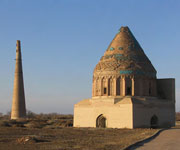Kunya-Urgench provides exceptional testimony to a cultural tradition (the Islamic culture of the Khorezm) and is unique in its state of preservation. The tradition of architecture expressed in the design and craftsmanship of Kunya-Urgench has been influential in the wider region to the south and south-west (Iran and Afghanistan) and later in the architecture of the Mughal Empire (16th-century Turkmenistan). The origins of Kunya-Urgench go back to the 6th or 5th centuries, the early Achaemenid period. In 712, Kunya-Urgench was invaded by Arabs and named Gurgandj. Being at the crossing of trade routes, the town prospered, becoming a major centre from the 10th-14th centuries. It was the capital of Khorezm from the 12th century and the second city after Bukhara in Central Asia.

Continent: Asia
Country: Turkmenistan
Category: Cultural
Criterion: (II)(III)
Date of Inscription: 2005
Kunya-Urgench Destroyed, Rebuilt
The city, destroyed by Genghis Khan in 1221 but rebuilt, was described as the finest city of the Turks with fine bazaars and impressive buildings. It was ravaged by Timurid troops between 1372 and 1388 and never regained its position. In the 16th century, the capital was transferred to Khiva, and the city was finally abandoned (the Amu Darya River changed its course at the same time). The city was newly colonized by Turkmen from 1831: however, the new development took place outside the old town, which later served as a graveyard.The southern section is limited on its east, south, and west sides by the remains of the 14th-century fortification walls. In the south-east corner there are the remains of the fortress of Ak-Kala. The centre of the section is partly occupied by the fortress of Tash-Kala, with the gate of a ruined caravanserai and the remaining base of the Mamunminaret. In the south-eastern corner there is the ruined fortress of Khorezm-bag, built as a residence for Khan Muhammed Emin in the mid-19th century.
 |
| Kunya-Urgench |
Browse Gallery Plus UNESCO Storyline
From Tash-Kala, a road leads to the northwest, passing by most other monuments in this section, all built from brick. These include the remains of the Kyrkmolla Fortress, dated to the 5th century BC, the period of the city's foundation. Kutlug-Timur Minaret is the most visible landmark of the site with its 60 m height and its brick surface has fine geometric patterns.
Il-Arslan Mausoleum is relatively small with a square plan and conical roof. The roof has geometric patterns in brick, and the front gate is surrounded by terracotta inscriptions. Tekesh Mausoleum has a similar form, but is bigger. Also here, the roof is decorated in brick patterns with some turquoise tiles still in position. Seyet Akhmet Mausoleum is simpler in its architecture. The present structure has been rebuilt after the original collapsed in 1993. Turabek-Khanum Mausoleum has an octagonal floor plan, with tall niches opening outward. The entrance is a tall gated structure. The original conical outer roof shell has collapsed. The interior has an exceptional spatial composition crowned with a dome of extremely refined blue and white decoration in a delicate geometric pattern.
The northern section consists of a large Muslim graveyard in the middle of modern urban development. In the centre of the graveyard there is a group of three buildings. Najm-ad-Din al-Kubra Mausoleum was built in the first half of the 14th century. It was named after Ahmed Ibn Omar Najm-ad-Din al-Kubra al-Khorezmi (born in 1145), the founder of the Kubravid School of Sufism, as well as being a painter, physician and chess master. The Sultan Ali Mausoleum is located opposite to the previous, and is linked with the name of Sultan Ali, who ruled in the 16th century. The Piryar Vali Mausoleum is a small complex built in the 13th-14th centuries. It contains the burial places of several distinguished persons. At the entrance in the east, the Dash Mosque, built in the early 20th century, has been converted into a site museum.
The western section is a small area in the western part of the old town. The monument of Ibn Khajib was built in honour of Ibn Khajib, a talented disciple of Najm-ad-Din al-Kubra. The ensemble was built in several phases from the 14th to 19th centuries.
Browse All UNESCO World Heritage Sites in
Turkmenistan. The original UNESCO inscription
Here!!!












0 comments:
Post a Comment